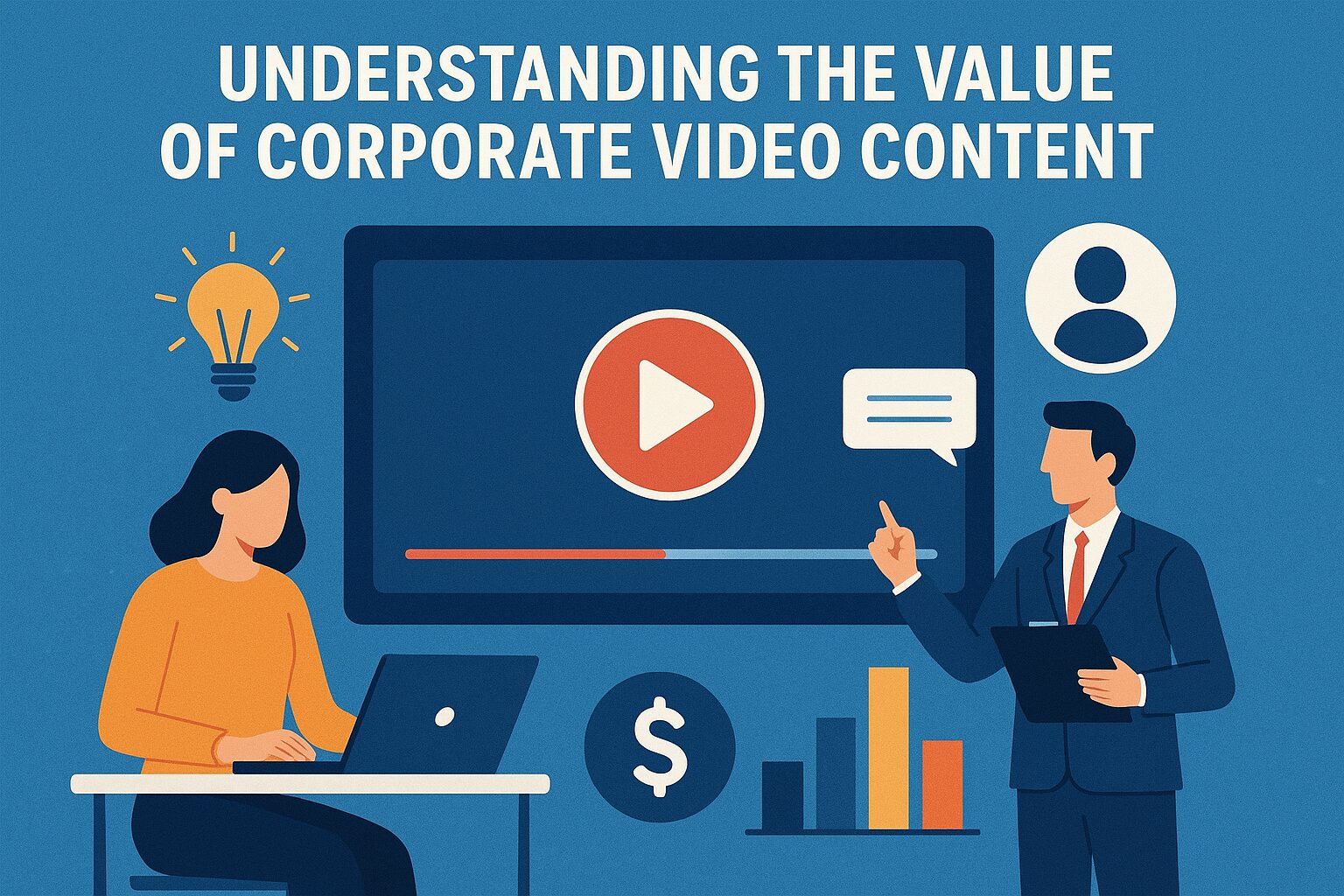Corporate video production has become one of the most effective tools for businesses looking to connect with their audience, convey their message, and establish a strong brand presence. The return on investment, or ROI, from corporate video content is not just about the money spent versus the money earned — it also reflects the value it brings in awareness, engagement, and brand trust. With so many companies competing for attention online, producing professional, well-crafted videos is no longer optional but essential for staying ahead.
The challenge for many businesses is not in recognising the benefits of corporate video, but in making sure the investment actually delivers measurable results. Every video project should start with a clear plan and end with a thorough evaluation of its impact. Without these steps, even the most visually impressive production can fall short of achieving its goals.
Setting Clear Objectives from the Start
Maximising ROI begins long before the camera starts rolling. Setting specific objectives is vital because the purpose of your video will determine the creative direction, the style of filming, and the platforms on which it is shared. A corporate video might aim to increase brand awareness, generate leads, train employees, or communicate important updates to stakeholders. Each of these purposes demands a different approach, and clarity at the planning stage will ensure the content is fit for its intended outcome.
These objectives should be measurable. If a video’s goal is to boost sales enquiries, you need a system in place to track exactly how many enquiries were generated through viewers who watched the content. If it is meant to raise brand awareness, look for data such as impressions, reach, and social shares to measure its effectiveness.
Investing in Quality Production
While it is possible to produce a video with limited resources, there is a clear link between high production values and perceived credibility. A professionally produced video not only looks and sounds better, but it also reflects positively on your brand. Poor lighting, unclear audio, or shaky footage can undermine the professionalism of your message, no matter how strong the content itself is.
A well-produced corporate video should also align with your brand identity. Everything from the colour palette and tone of voice to the choice of music should be consistent with your company’s overall image. This consistency strengthens brand recognition and makes the content more memorable. In the context of ROI, this means that every visual and audio element is working together to reinforce the viewer’s perception of your business.
Choosing the Right Format and Style
Not every corporate video needs to follow the same format. Different styles work better for different goals. For example, an animated explainer video may be perfect for breaking down complex products or services into simple terms, while a testimonial video featuring satisfied clients could be more effective for building trust. Case study videos, behind-the-scenes content, and live event coverage can all serve as powerful tools, but the choice of style must match the objectives set at the outset.
Length is also a crucial factor. Attention spans online are shorter than ever, so a concise, engaging video will often achieve better results than one that drags on. That said, certain formats, such as training videos or in-depth interviews, may require a longer runtime to be effective. The key is ensuring the length serves the purpose, rather than trying to fit the purpose into a pre-determined length.
Optimising for Multiple Platforms
A common mistake businesses make is creating a single version of their video and sharing it everywhere without adaptation. Each platform has its own requirements, audience behaviours, and best practices. A corporate video that works well as a three-minute piece on your website may need to be cut into shorter clips for social media. On LinkedIn, viewers may be willing to watch longer, more informative videos, while on Instagram or TikTok, shorter, visually striking content tends to perform better.
Optimisation also extends to technical considerations. File size, aspect ratio, and subtitles should all be tailored to suit the platform. Adding captions can significantly increase engagement, as many users watch videos with the sound off, particularly on mobile devices. By optimising for each platform, you maximise the chances of your content reaching and resonating with your target audience, directly boosting ROI.
Integrating Video into a Broader Marketing Strategy
To get the most value from your corporate video content, it should not stand alone. Videos are most effective when integrated into a wider marketing strategy. Embedding them on your website can improve dwell time and SEO performance, while including them in email campaigns can significantly increase click-through rates. Videos can also be used in paid advertising campaigns, targeting specific audiences to drive measurable results.
The synergy between video content and other marketing efforts amplifies its impact. For example, a well-crafted corporate video can be repurposed into multiple shorter clips for social media, still images for promotional materials, or even audio snippets for podcasts. This approach extends the lifespan of the content and maximises the return on your investment.
Measuring and Analysing Performance
Once the video has been produced and distributed, tracking its performance is essential. Modern analytics tools make it possible to monitor everything from view counts and watch times to conversion rates and audience demographics. This data provides valuable insights into what is working and what is not, enabling you to refine future productions for better results.
Beyond the raw numbers, it is important to assess qualitative feedback. Comments, shares, and direct responses from viewers can reveal whether your message resonated as intended. If the goal was to increase engagement with your brand, a high level of interaction and discussion may be just as valuable as direct sales leads.
Encouraging Audience Interaction
One of the most effective ways to increase ROI from corporate video content is to encourage viewers to take action. This could be as simple as including a clear call to action at the end of the video, directing viewers to visit your website, sign up for a newsletter, or contact your business. Interactive elements, such as clickable links, embedded forms, or QR codes, can make it easier for viewers to engage immediately.
If your business is active on social media, creating opportunities for audience participation can extend the reach of your video content. Asking viewers to share their own experiences, respond to questions, or enter a competition related to the video can significantly boost engagement levels.
Refreshing and Repurposing Older Content
Producing a high-quality corporate video requires an investment of both time and money, so it makes sense to get as much value from it as possible. One way to do this is by revisiting older videos to see if they can be updated or repurposed. This could involve editing in new branding elements, updating statistics, or creating a condensed version for a different platform.
Repurposing content not only extends its lifespan but also allows you to reach new audiences who may have missed it the first time. A video that was originally produced for a product launch, for example, could later be adapted into a case study or testimonial once customer feedback becomes available.
The Role of Professional Expertise
While some businesses choose to handle video production in-house, working with professional corporate video producers can often deliver a stronger ROI. Experienced professionals bring technical skills, creative insight, and a deep understanding of how to craft a message that connects with the intended audience. They can also ensure that the video is technically sound, visually appealing, and strategically aligned with your business goals.
The expertise of a professional team can be particularly valuable when it comes to distribution and optimisation. Knowing how to position the video in search results, leverage social media algorithms, and target specific audience segments can dramatically increase its reach and effectiveness.
Keeping Content Relevant and Timely
Relevance is a key factor in whether a corporate video delivers a strong ROI. Content that feels out of date or disconnected from current trends will struggle to engage audiences. Businesses should aim to produce videos that speak to timely issues, industry developments, or changes in customer needs.
Seasonal content can also be effective, particularly for companies with products or services that align with specific times of year. By planning your video content calendar in advance, you can ensure that each release coincides with moments when your audience is most likely to be receptive.
Maximising ROI Beyond Direct Sales
While many companies measure ROI purely in terms of sales or leads, corporate video content can deliver value in other ways. Internal communications videos, for example, can improve staff engagement and retention. Recruitment videos can help attract the right candidates, saving time and resources in the hiring process. Brand awareness videos may not generate immediate sales, but they can lay the groundwork for future business growth.
By recognising these indirect benefits, businesses can gain a fuller picture of the value their corporate video content brings. The key is to track relevant metrics for each objective and view ROI through a wider lens than just financial returns.



































